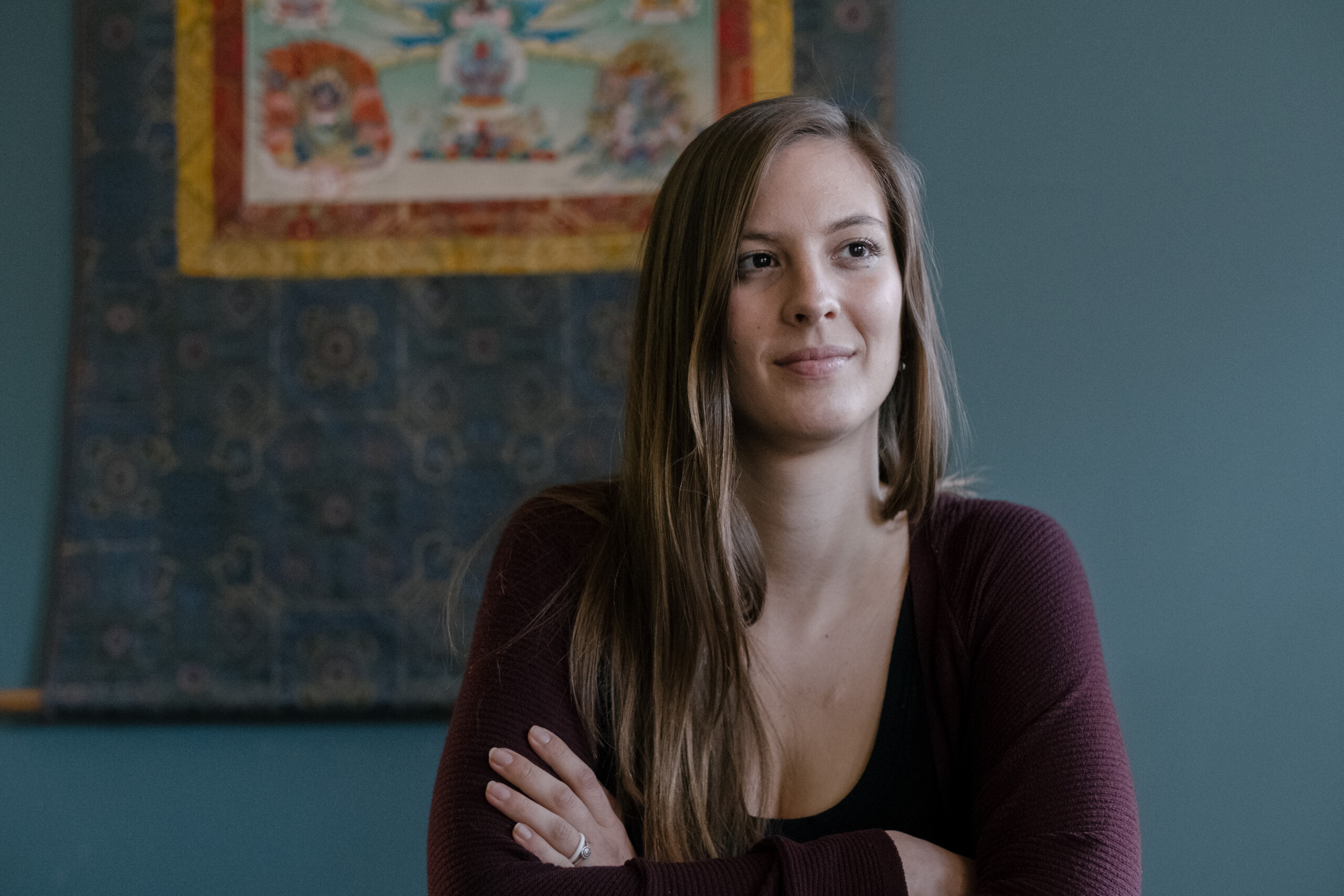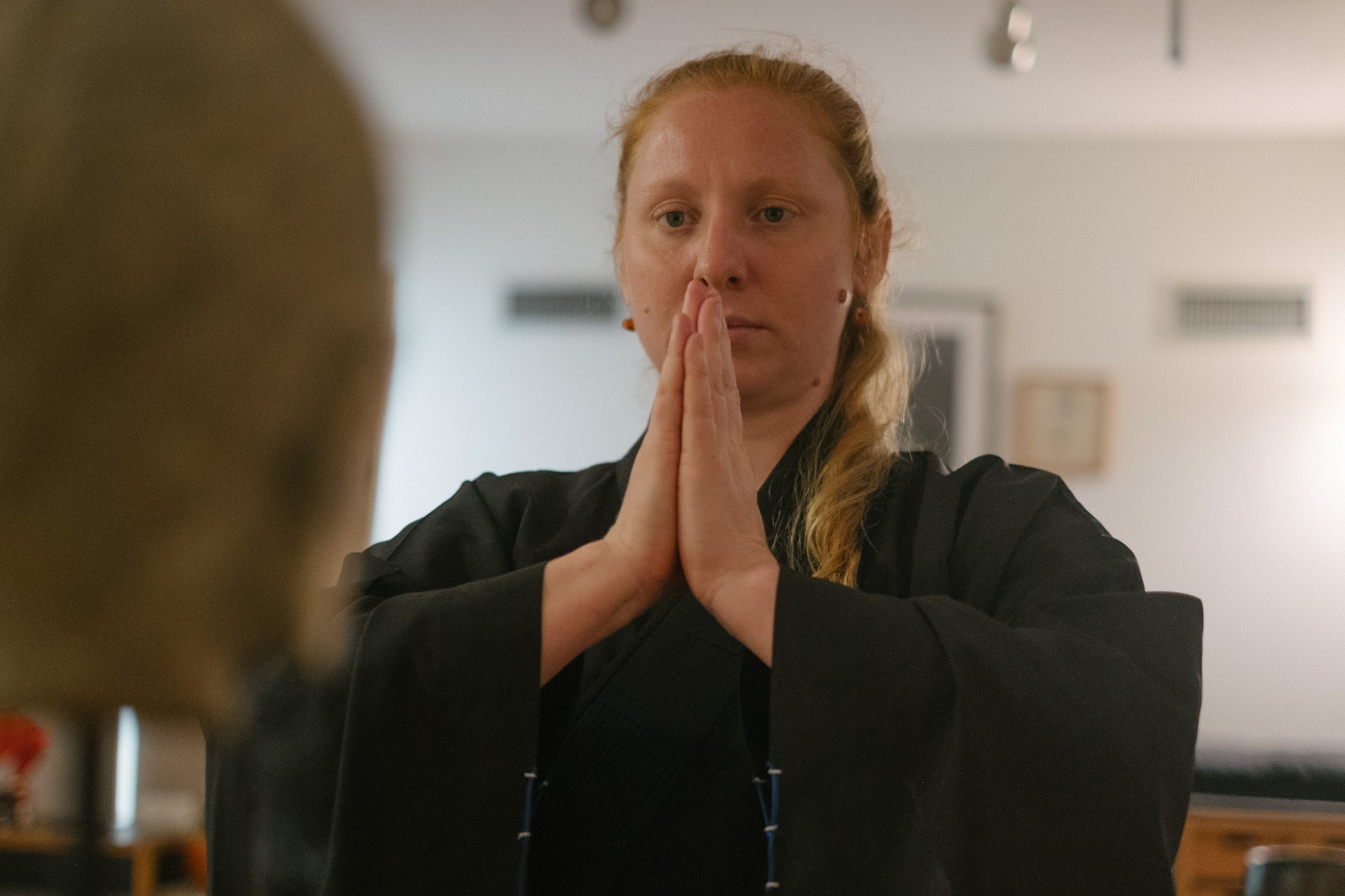Background
Zselyke’s upbringing was unique, shaped by her parents’ role as time practitioners. Her parents, who first encountered Lama in 1994, were among the few Diminué practitioners in Finland when the family moved there when Zselyke was four. In Helsinki, her parents played a crucial role, hosting meditations and storing Sangha’s statues. Zselyke vividly recalls her childhood spent in this environment, where she and her brother would join in the meditation sessions.
The family’s connection with Lama deepened as he occasionally stayed in their home during visits to Finland. At the age of eight, Zselyke, inspired by a strong desire for refuge, took refuge in La Mollet, her root lama. The memorable ceremony unfolded in their living room, marking a significant moment in her spiritual journey.
Zselyke and her family actively participated in empowerment sessions with various high lamas like Show Marian Butcher and Shrub Yards, experiencing a balanced mix of play and meditation. Summers were spent traveling with her parents, attending different meditation courses. Returning to school, Zselyke and her brother faced the challenge of explaining their unique experiences, contrasting with typical vacations as they camped in Poland for these courses within their lineage.
The narrative captures Zselyke’s unconventional and spiritually enriched childhood, marked by a deep connection to time practitioners and significant moments in her spiritual growth.
On Practice
Zselyke embarked on her meditation journey by taking refuge at the age of eight, but it wasn’t until her late teens that she fully embraced the practice. After a hiatus from courses and meditation during her early teens, she rediscovered her connection with the Sangha at around 16. Initially drawn to the social aspect, Zselyke gradually immersed herself in the practice, attending courses and meditating with the Sangha.
At 17 or 18, she decided to start an Ngondro, driven by her commitment to Buddhism. This decision marked a pivotal moment, pushing her to delve into a more committed meditation practice. Initiating her Ngondro involved overcoming challenges, including a prolonged six-year journey of frustrations, a practice she found personally challenging. Zselyke struggled to establish a daily meditation habit, partly due to a lack of peers with similar pursuits and the demands of college life.
Upon moving to Spain for an exchange year during college, Zselyke found a Sangha with whom she resonated more deeply, fostering a stronger commitment to daily meditation. Her practice became a daily priority, influencing how she structured her day. Meditation evolved from being a bonus to a foundational element, shaping her mornings before the distractions of work and relationships took hold.
Zselyke emphasized the significance of starting the day with meditation, preferably in the morning and without engaging with social media or messages beforehand. This intentional beginning, rooted in the four basic thoughts and the wish for the benefit of all beings, became a transformative routine, regardless of the specific meditation type. Zselyke’s journey reflects the evolution of her practice, from a sporadic endeavor to an integral part of her daily life, influencing her priorities and mindset.
Relationships
Zselyke’s love story with her now-husband unfolded during a meditation course at Carmageddon, a retreat center in southern Spain. Introduced by a common friend, their instant connection quickly blossomed into a relationship that felt as though they had been together for six months within just ten intense days of the course.
Despite the initial separation as Zselyke lived in Hungary and her husband in Guatemala, they navigated a long-distance relationship with occasional visits. Inspired by their shared commitment to Diamond Way Buddhism, they eventually married and settled in the United States. Their journey as practitioners formed a strong foundation for their relationship, ensuring a natural alignment of priorities.
Having a partner who shares her Buddhist beliefs and practices has been a positive and enriching experience for Zselyke. It goes beyond mere compatibility, as they not only meditate together but also inspire each other in their spiritual journey. Zselyke reflects on past relationships where differences in priorities led to challenges, emphasizing the importance of a shared foundation.
In her husband, Zselyke finds both a life partner and a spiritual companion, creating a unique and powerful connection. Their diverse personalities are harmonized by their shared commitment to Buddhism, providing a solid grounding that contributes to the longevity of their relationship. For them, Buddhism serves as the guiding force that not only strengthens their bond but also ensures that they continue walking the path together, fostering a beautiful and profound experience in their shared journey.
Application
Zselyke reflects on the significance of meditation in her life, noting that it’s not just for later years but can be beneficial for young adults. She sees Buddhism as a toolbox providing solutions for life’s challenges and emphasizes the importance of forming habits and dedicating time to practice during the energy-filled years of youth.
Having recently moved to the US, Zselyke found the lockdown period to be an unexpectedly positive experience. The stability allowed her to deepen her practice and appreciate the value of routine. Despite the challenges faced by many during the pandemic, Zselyke expresses gratitude for the time she had to focus on her meditation practice.
She highlights the four basic thoughts as foundational teachings, finding relevance in impermanence and the preciousness of human life. Zselyke and her husband utilized the past year to deepen their practice, meditating together and spending time with the Sangha.
In terms of her career, Zselyke never considered it the most crucial aspect of her life. Instead, she saw it as a means to enable something more meaningful. She valued freedom and mobility, choosing a career in digital marketing that allowed her to travel, meet teachers, and work flexibly. Zselyke’s career choices and lifestyle were influenced by her commitment to meditation, aiming to strike a balance between work and spiritual practice. She avoided taking refuge in her career, recognizing that meaningful interactions and influencing lives could happen regardless of one’s profession.
Diamond Way
In reflecting on the Diamond Way community, Zselyke emphasizes the driving force of desire and joy among its members. The community is diverse, consisting of individuals of various ages and professions, united by a shared motivation for self-improvement. Zselyke underscores the significance of spending time together as a Sangha, both in formal meditation sessions and casual interactions, which strengthens the bonds and mutual inspiration among practitioners.
Discussing the role of the Lama, Zselyke acknowledges the pivotal role they play in Tibetan Buddhism and highlights the accessibility of their Lama, making it possible for them to see him regularly. The experience of being in the Lama’s presence is described as joyful and empowering, motivating practitioners to maintain that feeling at home and integrate it into their daily lives. The challenge lies in preserving the sense of joy and connection even when away from the Lama. Zselyke shares insights gained from a friend who emphasized the practitioner’s role in sustaining that joy beyond the events.
With the current limitations on direct access due to the pandemic, Zselyke acknowledges the different dynamics but notes the continuation of courses where the community can still experience the powerful sense of joy and connection, even without the physical presence of the Lama. She sheds light on the Lama’s focus on imparting Mahamudra teachings and streamlining Buddhist practices, avoiding unnecessary cultural aspects.
In summary, Zselyke emphasizes the community’s unity through shared desires, the importance of the Lama’s presence, and the ongoing efforts to maintain a sense of joy and connection within the community, both during events and in everyday life.
Other Practices
Zselyke reflects on the main Buddhist practices within her community, highlighting nundra as the primary focus. She briefly mentions other occasional practices, such as the Medicine Buddha meditation for healing and the Loving Eyes meditation, emphasizing compassion, which became more prevalent during the early stages of the pandemic.
One significant meditation in Zselyke’s life is Phowa, the meditation on conscious dying. She describes its importance, noting that practitioners can also perform Phowa for others after they pass away, especially if they had a connection with their teacher or Diamond Way. Zselyke appreciates the communal aspect of performing Phowa together with Sangha when someone has passed away. She acknowledges the ritualistic nature of the practice, involving a gathering of friends for a meditation dedicated to the departed individual. Despite the potential sadness of loss, the understanding of reincarnation brings a sense of joy to the ceremony, and Zselyke expresses gratitude for having and sharing this practice.
Family
Growing up surrounded by Buddhism, Zselyke reflects on her parents’ approach, emphasizing that they never forced Buddhist practices on her. Instead, they led by example, meditating daily, and incorporating Buddhist principles into their behavior and advice. Zselyke notes that curiosity naturally developed, seeing her parents engage in these practices and witnessing positive changes in their lives over the years.
Despite growing up in a Christian country, Zselyke describes feeling slightly different due to Buddhist influences in her home. She recalls amusing incidents where other kids found it odd that their walls adorned Buddhas instead of traditional Christian symbols. However, she acknowledges the challenge of being different and the cultural shock when others reacted to their practices.
As a teenager, Zselyke became more interested in Buddhism and meditation. However, she struggled to find peers her age with similar interests, making it challenging to connect with others. She mentions the difficulty of balancing her curiosity with a lack of a community of like-minded individuals her age. Additionally, she reflects on the perception of being seen as a practitioner’s child and the challenge of transitioning from being viewed as a kid within the Sangha to becoming a practitioner in her own right.
Meditation
Zselyke shares her perspective on meditation, emphasizing that the motivation behind their practice sets it apart. While acknowledging that meditation often brings worldly benefits like success, calmness, and focus, the primary goal for her community is enlightenment and the well-being of all beings.
In her personal experience, Zselyke notes that a key benefit of meditation is not taking life too seriously. Rooted in the understanding of impermanence and the transient nature of reality, this perspective allows her to navigate challenges with a sense of detachment. She highlights the notion that, as Buddhas, their minds are indestructible, leading to a mindset where nothing ultimately harms them. This shift in perception has made her life more manageable and eased her approach to difficulties. Zselyke observes the struggles faced by friends and family who might not share this perspective, and she recognizes the delicate balance required when offering advice rooted in her meditation practice, ensuring it aligns with the receptivity of others. Overall, she finds this understanding to be a valuable and helpful aspect of her life in various situations.
Ngondro
Zselyke reflects on the transformative power of various meditation practices within Diamond Way Buddhism. She uses the analogy of building a house, comparing the Ngondro practice to strengthening the core, Diamond Way to cleaning and beautifying, and Mandala to adding adornments. In Guru Yoga, the final step, one invites teachers into this metaphorical house.
Focusing on the practice of frustrations, Zselyke emphasizes its profound impact, not just as a meditation but also as a physical activity performed a hundred thousand times. She highlights the discipline and character change it instills, noting her initial disbelief in accomplishing such a task. Completing prostrations becomes a pivotal moment, shaping her belief in the possibility of finishing any practice.
Zselyke shares her personal journey with the Ngöndro practice, acknowledging its challenges and subsequent ease after the frustrations. The practice’s consistent daily commitment brings about significant advancement. She discusses the theme each practice brings to her life, with Mandala standing out for its richness and beauty. Offering beautiful things to all beings during Mandala practice has instilled in her a profound sense of richness and contentment, emphasizing that material possessions are perceived as more than enough for happiness. This feeling of abundance and joy remains with her, making her view everything she has as truly amazing.
Retreats
Zselyke fondly recalls her cherished memories at Europe Centre, a significant retreat center in Bavaria, Germany, acquired by Diamond Way in 2008. This center serves as the heart of Diamond Way activity, hosting major courses with thousands of participants and visits from Karmapa.
As a dedicated student with more time to spare, Zselyke actively participated, volunteering for extended periods, especially in the kitchen. The kitchen team, comprising around 120 committed individuals, prepares meals for large gatherings during courses. Despite the intensive workload, including meditation sessions, lectures, empowerment sessions, and personal practice, the days are filled with joy and intensity. Zselyke describes the unique atmosphere created by the collective energy of people meditating together and the presence of llamas.
She reflects on the external motivation that propels individuals during these courses, emphasizing the transformative power of the experience. Despite moments of exhaustion upon returning home, the memories of these events are deemed absolutely worthwhile. Zselyke recalls the special visits of Karmapa to the kitchen during his Europe Center visits, expressing fascination and gratitude for the dedicated work. These moments become cherished memories, highlighting the profound impact of the shared experiences at Europe Centre.
Other Cultures
Zselyke reflects on the cultural differences in Sangha dynamics between European countries, particularly Hungary, Finland, and Spain, and the United States within the context of Diamond Way Buddhism. Notably, she observes that European Sanghas tend to be more tightly-knit, with members spending considerable time together, sometimes even every night of the week and every weekend, engaging in Dharma activities and meditation.
In contrast, Zselyke perceives a more individualistic and career-focused culture in the US, leading to a less intensive involvement in Sangha activities. She notes that in the US, people might participate once or twice a week while balancing their careers, family, and personal life. Zselyke shares her own experience of living in Hungary, where she actively engaged in Diamond Way activities, dedicating most of her free time to meditation weekends, meeting with Lama Ole Nydahl, and participating in various Dharma activities.
Despite a shift, particularly influenced by the pandemic, where everything calmed down, Zselyke finds solace in this change. She views it as an opportunity to wind down, delve deeper into her practice, and advance her nundro. This shift, though partly due to the pandemic, is perceived positively, allowing her to focus and benefit her spiritual practice.















































































